Twinning Behavior, Microstructure Evolution and Mechanical Property of Random-Orientated ZK60 Mg Alloy Compressed at Room Temperature
Abstract
1. Introduction
2. Materials and Methods
2.1. Materials Preparation
2.2. Microstructure Characterization
2.3. Electron Backscatter Diffraction Analyzation
2.4. Room Temperature Compression
2.5. Hardness Test
3. Results
3.1. Microstructure Characterization of Initial ZK60 Alloy
3.2. The Compression Curves
3.3. Microstructure Evolution
3.4. Orientation Statistics
3.5. The Evolution of the Schmid Factor
3.6. The Interaction between Twin and Participate Phase
4. Discussion
4.1. The Relationship between Twinning and Strain Hardening at Room Temperature
4.2. The Mechanical Property Related to Twinning
5. Conclusions
- (1)
- At the beginning of deformation, the {10-12} extension twinning is one of the main deformation mechanisms and is responsible for the basal texture. Accompanied by the formation of strong basal texture in the middle and late stage of deformation, compression twinning and deformation band occurred, which is the main source of crack initiation leading to failure.
- (2)
- Slip is also an indispensable deformation mechanism. Basal slip still kept sufficient to activate during the whole compression process. With the strain increase and texture evolution, non-basal slip gradually turned from prismatic slip to pyramidal <c + a> slip.
- (3)
- During compression, the interaction between the twins, and the interaction between twin boundaries and dislocations can significantly enhance the strain hardening rate of Mg alloy, and these two interactions together with the segmentation of grains by twin boundaries improve the mechanical properties of ZK60 alloy.
- (4)
- The fine and dense precipitates of Mg-Zn phase in ZK60 Mg alloy will not be cut when sheared by the twin boundary, but is rotated by a small angle. The precipitation may hinder the growth of twins, but promote the nucleation of twinning.
Author Contributions
Funding
Institutional Review Board Statement
Informed Consent Statement
Data Availability Statement
Conflicts of Interest
References
- Joost, W.J.; Krajewski, P.E. Towards magnesium alloys for high-volume automotive applications. Scr. Mater. 2017, 128, 107–112. [Google Scholar] [CrossRef]
- Weiler, J.P.; Wood, J.T. Modeling the tensile failure of cast magnesium alloys. J. Alloys Compd. 2012, 537, 133–140. [Google Scholar] [CrossRef]
- Gao, M.; He, G.H.; Huang, T.; Wang, C.Y.; Wu, C.; Yu, G.Y. Reducing the Shrinkage Defects in the ZA27 Casting Alloy by Using Electric Pulse Current. In Proceedings of the 3rd International Conference on Manufacturing Science and Engineering (ICMSE 2012), Xiamen, China, 27–29 March 2012; pp. 1082–1086. [Google Scholar]
- Jiang, M.G.; Yan, H.; Gao, L.; Chen, R.S. Microstructural evolution of Mg-7Al-2Sn Mg alloy during multi-directional impact forging. J. Magnes. Alloys 2015, 3, 180–187. [Google Scholar] [CrossRef]
- Yamashita, A.; Horita, Z.; Langdon, T.G. Improving the mechanical properties of magnesium and a magnesium alloy through severe plastic deformation. Mater. Sci. Eng. A 2001, 300, 142–147. [Google Scholar] [CrossRef]
- Hong, M.; Wu, D.; Chen, R.S.; Du, X.H. Ductility enhancement of EW75 alloy by multi-directional forging. J. Magnes. Alloys 2014, 2, 317–324. [Google Scholar] [CrossRef]
- Wang, T.; Zha, M.; Du, C.; Jia, H.-L.; Wang, C.; Guan, K.; Gao, Y.; Wang, H.-Y. High strength and high ductility achieved in a heterogeneous lamella-structured magnesium alloy. Mater. Res. Lett. 2023, 11, 187–195. [Google Scholar] [CrossRef]
- Wan, Y.; Tang, B.; Gao, Y.; Tang, L.; Sha, G.; Zhang, B.; Liang, N.; Liu, C.; Jiang, S.; Chen, Z.; et al. Bulk nanocrystalline high-strength magnesium alloys prepared via rotary swaging. Acta Mater. 2020, 200, 274–286. [Google Scholar] [CrossRef]
- Hwang, D.Y.; Shimamoto, A.; Kubota, R. A Study on the Fracture Behavior of Magnesium and Aluminium Alloy under Dynamic Biaxial Stress. Key Eng. Mater. 2005, 297–300, 1579–1584. [Google Scholar] [CrossRef]
- Lee, S.; Ham, H.J.; Kwon, S.Y.; Kim, S.W.; Suh, C.M. Thermal Conductivity of Magnesium Alloys in the Temperature Range from −125 °C to 400 °C. Int. J. Thermophys. 2013, 34, 2343–2350. [Google Scholar] [CrossRef]
- Woodcraft, A.L. Predicting the thermal conductivity of aluminium alloys in the cryogenic to room temperature range. Cryogenics 2005, 45, 421–431. [Google Scholar] [CrossRef]
- Peet, M.J.; Hasan, H.S.; Bhadeshia, H.K.D.H. Prediction of thermal conductivity of steel. Int. J. Heat Mass Transf. 2011, 54, 2602–2608. [Google Scholar] [CrossRef]
- Li, J.L.; Wang, X.X.; Zhang, N.; Wu, D.; Chen, R.S. Ductility drop of the solutionized Mg-Gd-Y-Zr alloy during tensile deformation at 350 °C. J. Alloys Compd. 2017, 714, 104–113. [Google Scholar] [CrossRef]
- Peng, R.; Xu, C.; Li, Y.; Zhong, S.; Cao, X.; Ding, Y. Multiple-twinning induced recrystallization and texture optimization in a differential-temperature-rolled AZ31B magnesium alloy with excellent ductility. Mater. Res. Lett. 2022, 10, 318–326. [Google Scholar] [CrossRef]
- Kada, S.R.; Lynch, P.A.; Kimpton, J.A.; Barnett, M.R. In-situ X-ray diffraction studies of slip and twinning in the presence of precipitates in AZ91 alloy. Acta Mater. 2016, 119, 145–156. [Google Scholar] [CrossRef]
- Al-Samman, T.; Gottstein, G. Dynamic recrystallization during high temperature deformation of magnesium. Mater. Sci. Eng. A 2008, 490, 411–420. [Google Scholar] [CrossRef]
- Zhang, H.; Li, Y.X.; Zhu, G.M.; Zhu, Q.C.; Qi, X.X.; Zheng, D.F.; Zeng, X.Q. Crystallographic features of <11¯00> axis tilt boundaries in a high strain rate deformed Mg-9Y alloy. Mater. Charact. 2021, 182, 111522. [Google Scholar] [CrossRef]
- Jalali, M.S.; Zarei-Hanzaki, A.; Mosayebi, M.; Abedi, H.R.; Malekan, M.; Kahnooji, M.; Farabi, E.; Kim, S.-H. Unveiling the influence of dendrite characteristics on the slip/twinning activity and the strain hardening capacity of Mg-Sn-Li-Zn cast alloys. J. Magnes. Alloys 2022. [Google Scholar] [CrossRef]
- Hong, L.; Wang, R.; Zhang, X. Effects of Nd on microstructure and mechanical properties of as-cast Mg-12Gd-2Zn-xNd-0.4Zr alloys with stacking faults. Int. J. Miner. Metall. Mater. 2022, 29, 1570–1577. [Google Scholar] [CrossRef]
- Jiang, L.; Jonas, J.J.; Luo, A.A.; Sachdev, A.K.; Godet, S. Influence of {10-12} extension twinning on the flow behavior of AZ31 Mg alloy. Mater. Sci. Eng. A 2007, 445–446, 302–309. [Google Scholar] [CrossRef]
- Li, L.; Liu, W.; Qi, F.; Wu, D.; Zhang, Z. Effects of deformation twins on microstructure evolution, mechanical properties and corrosion behaviors in magnesium alloys—A review. J. Magnes. Alloys 2022, 10, 2334–2353. [Google Scholar] [CrossRef]
- Stanford, N.; Marceau, R.K.W.; Barnett, M.R. The effect of high yttrium solute concentration on the twinning behaviour of magnesium alloys. Acta Mater. 2015, 82, 447–456. [Google Scholar] [CrossRef]
- Wang, B.; Wang, F.; Wang, Z.; Zhou, L.; Liu, Z.; Mao, P. Compressive deformation behavior of ultrafine-grained Mg-3Zn-1.2Ca-0.6Zr alloy at room temperature. J. Alloys Compd. 2021, 871, 159581. [Google Scholar] [CrossRef]
- Tahaghoghi, M.; Zarei-Hanzaki, A.; Jalali, M.S.; Abedi, H.R. Improved strength and plasticity of magnesium matrix nanocomposites reinforced by carbonaceous nanoplatelets and micro-clusters. J. Mater. Res. Technol. 2022, 21, 2797–2814. [Google Scholar] [CrossRef]
- Wang, B.; Xin, R.; Huang, G.; Liu, Q. Effect of crystal orientation on the mechanical properties and strain hardening behavior of magnesium alloy AZ31 during uniaxial compression. Mater. Sci. Eng. A 2012, 534, 588–593. [Google Scholar] [CrossRef]
- Barnett, M.R.; Ghaderi, A.; Quinta da Fonseca, J.; Robson, J.D. Influence of orientation on twin nucleation and growth at low strains in a magnesium alloy. Acta Mater. 2014, 80, 380–391. [Google Scholar] [CrossRef]
- Tao, J.-Q.; Cheng, Y.-S.; Huang, S.-D.; Peng, F.-F.; Yang, W.-X.; Lu, M.-Q.; Zhang, Z.-M.; Jin, X. Microstructural evolution and mechanical properties of ZK60 magnesium alloy prepared by multi-axial forging during partial remelting. Trans. Nonferrous Met. Soc. China 2012, 22 (Suppl. S2), 428–434. [Google Scholar] [CrossRef]
- Chen, H.; Zang, Q.; Yu, H.; Zhang, J.; Jin, Y. Effect of intermediate annealing on the microstructure and mechanical property of ZK60 magnesium alloy produced by twin roll casting and hot rolling. Mater. Charact. 2015, 106, 437–441. [Google Scholar] [CrossRef]
- Fu, W.; Wang, R.; Zhang, J.; Wu, K.; Liu, G.; Sun, J. The effect of precipitates on voiding, twinning, and fracture behaviors in Mg alloys. Mater. Sci. Eng. A 2018, 720, 98–109. [Google Scholar] [CrossRef]
- Robson, J.D.; Stanford, N.; Barnett, M.R. Effect of precipitate shape on slip and twinning in magnesium alloys. Acta Mater. 2011, 59, 1945–1956. [Google Scholar] [CrossRef]
- Fan, H.; Aubry, S.; Arsenlis, A.; El-Awady, J.A. The role of twinning deformation on the hardening response of polycrystalline magnesium from discrete dislocation dynamics simulations. Acta Mater. 2015, 92, 126–139. [Google Scholar] [CrossRef]
- Jiang, L.; Jonas, J.J.; Mishra, R.K.; Luo, A.A.; Sachdev, A.K.; Godet, S. Twinning and texture development in two Mg alloys subjected to loading along three different strain paths. Acta Mater. 2007, 55, 3899–3910. [Google Scholar] [CrossRef]
- Koike, J. Enhanced deformation mechanisms by anisotropic plasticity in polycrystalline Mg alloys at room temperature. Metall. Mater. Trans. A 2005, 36, 1689–1696. [Google Scholar] [CrossRef]
- Lu, D.; Wang, S.; Lan, Y.; Zhang, K.; Li, W.; Li, Q. Statistical Analysis of Grain-Scale Effects of Twinning Deformation for Magnesium Alloys under Cyclic Strain Loading. Materials 2020, 13, 2454. [Google Scholar] [CrossRef] [PubMed]
- Chen, P.; Li, B.; Culbertson, D.; Jiang, Y. Contribution of extension twinning to plastic strain at low stress stage deformation of a Mg-3Al-1Zn alloy. Mater. Sci. Eng. A 2018, 709, 40–45. [Google Scholar] [CrossRef]
- Chapuis, A.; Driver, J.H. Temperature dependency of slip and twinning in plane strain compressed magnesium single crystals. Acta Mater. 2011, 59, 1986–1994. [Google Scholar] [CrossRef]
- El Kadiri, H.; Kapil, J.; Oppedal, A.L.; Hector, L.G.; Agnew, S.R.; Cherkaoui, M.; Vogel, S.C. The effect of twin–twin interactions on the nucleation and propagation of {101¯2} twinning in magnesium. Acta Mater. 2013, 61, 3549–3563. [Google Scholar] [CrossRef]
- Gui, Y.; Li, Q.; Xue, Y.; Ouyang, L. Twin-twin geometric structure effect on the twinning behavior of an Mg-4Y-3Nd-2Sm-0.5Zr alloy traced by quasi-in-situ EBSD. J. Magnes. Alloys 2021, in press. [Google Scholar] [CrossRef]
- Mokdad, F.; Chen, D.L.; Li, D.Y. Single and double twin nucleation, growth, and interaction in an extruded magnesium alloy. Mater. Des. 2017, 119, 376–396. [Google Scholar] [CrossRef]
- Gui, Y.; Cui, Y.; Bian, H.; Li, Q.; Ouyang, L.; Chiba, A. Role of slip and {10-12} twin on the crystal plasticity in Mg-RE alloy during deformation process at room temperature. J. Mater. Sci. Technol. 2021, 80, 279–296. [Google Scholar] [CrossRef]
- Robson, J.D.; Stanford, N.; Barnett, M.R. Effect of particles in promoting twin nucleation in a Mg-5 wt.% Zn alloy. Scr. Mater. 2010, 63, 823–826. [Google Scholar] [CrossRef]
- Drozdenko, D.; Dobroň, P.; Yi, S.; Horváth, K.; Letzig, D.; Bohlen, J. Mobility of pinned twin boundaries during mechanical loading of extruded binary Mg-1Zn alloy. Mater. Charact. 2018, 139, 81–88. [Google Scholar] [CrossRef]
- Zhao, C.; Li, Z.; Shi, J.; Chen, X.; Tu, T.; Luo, Z.; Cheng, R.; Atrens, A.; Pan, F. Strain hardening behavior of Mg–Y alloys after extrusion process. J. Magnes. Alloys 2019, 7, 672–680. [Google Scholar] [CrossRef]
- Liu, T.; Pan, F.; Zhang, X. Effect of Sc addition on the work-hardening behavior of ZK60 magnesium alloy. Mater. Des. 2013, 43, 572–577. [Google Scholar] [CrossRef]
- Ang, H.Q. Modelling of the Strain Hardening Behaviour of Die-Cast Magnesium-Aluminium-Rare Earth Alloy. Adv. Eng. Forum 2020, 35, 1–8. [Google Scholar] [CrossRef]
- Tong, L.B.; Zheng, M.Y.; Xu, S.W.; Hu, X.S.; Wu, K.; Kamado, S.; Wang, G.J.; Lv, X.Y. Room-temperature compressive deformation behavior of Mg–Zn–Ca alloy processed by equal channel angular pressing. Mater. Sci. Eng. A 2010, 528, 672–679. [Google Scholar] [CrossRef]
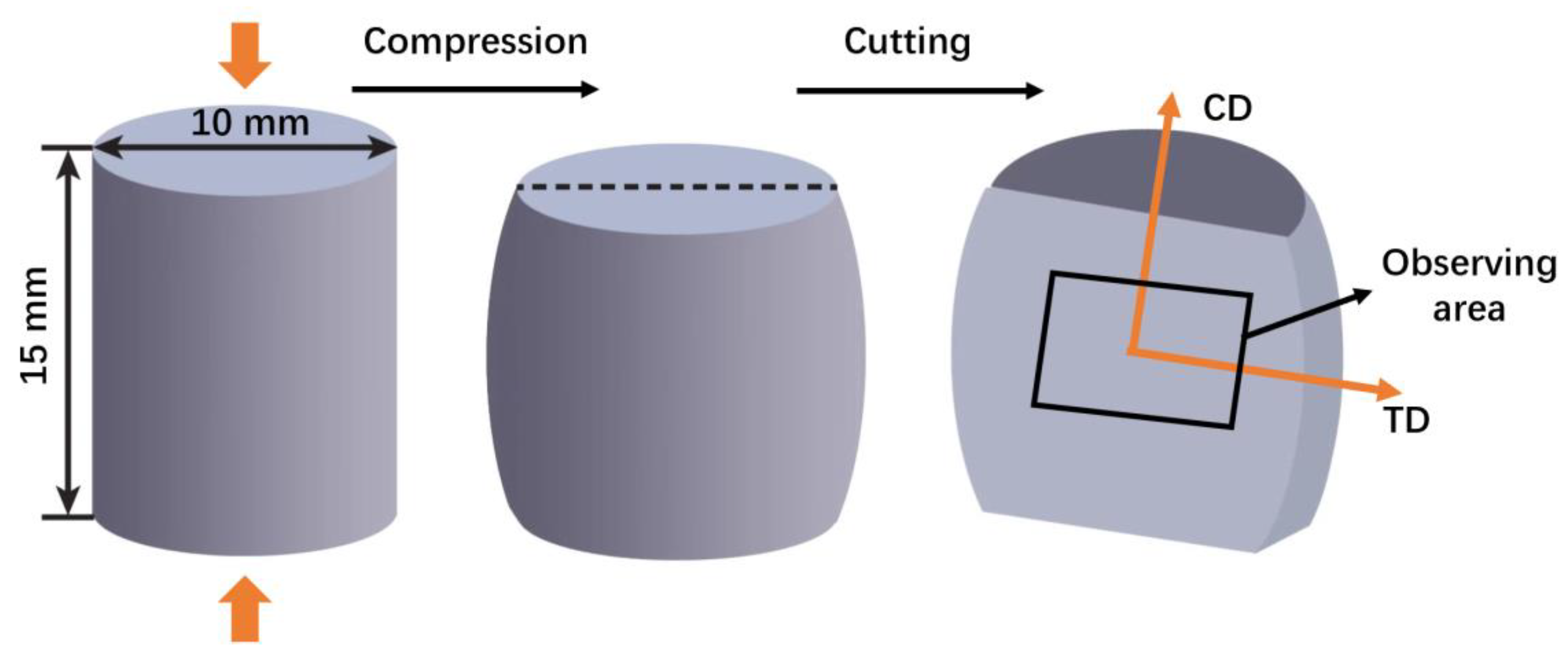
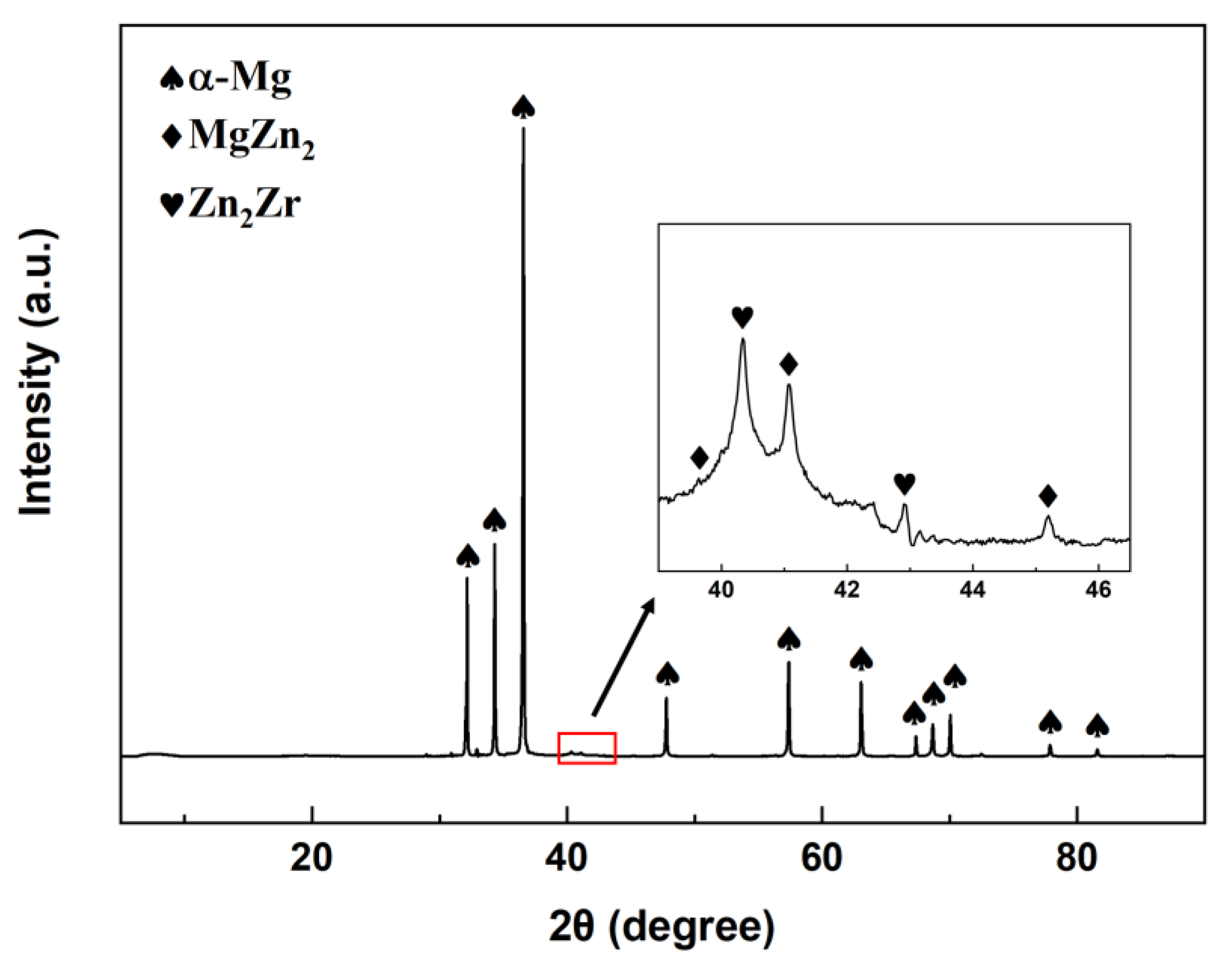
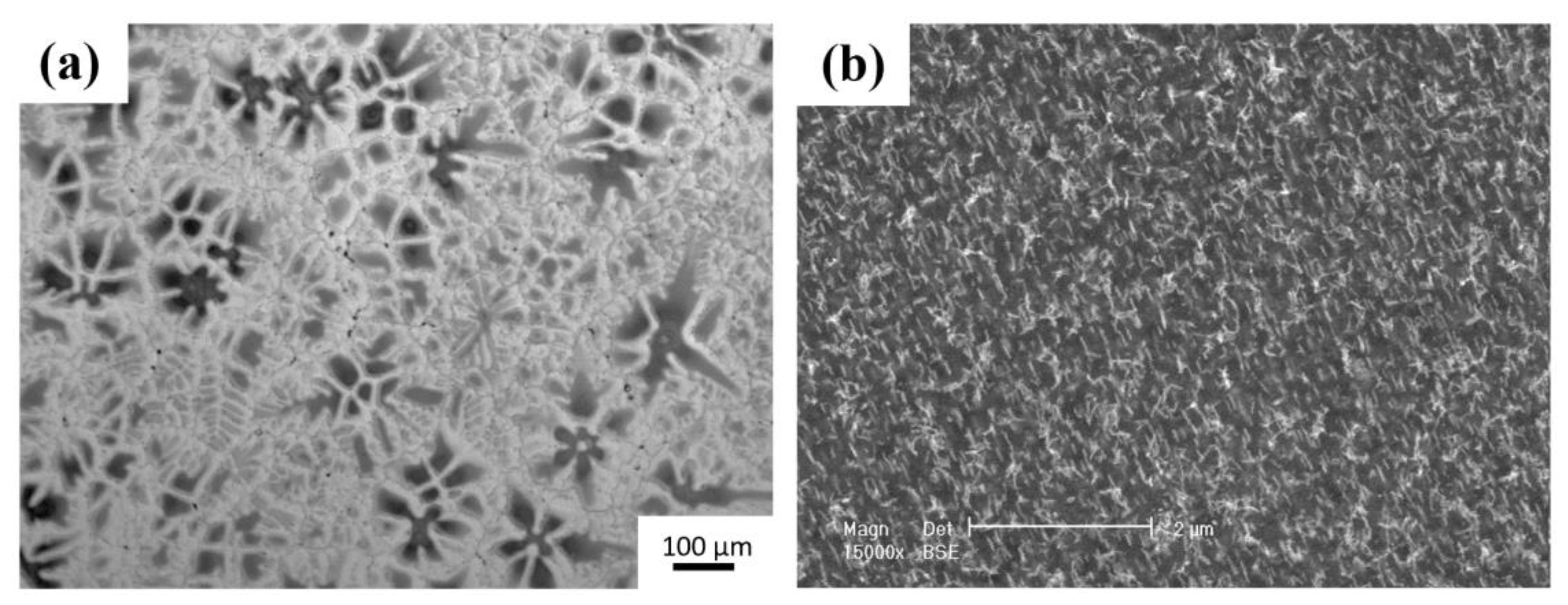



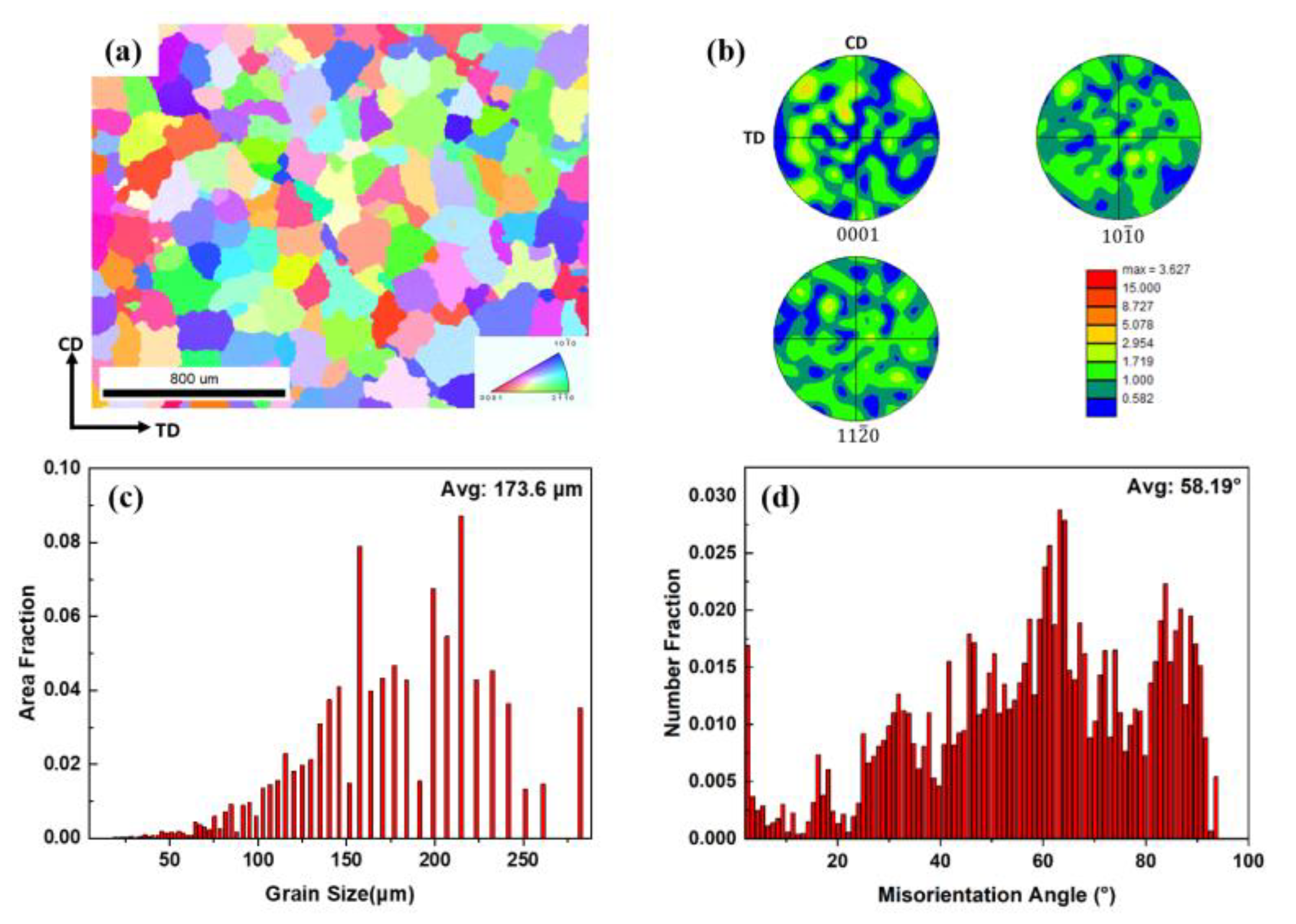
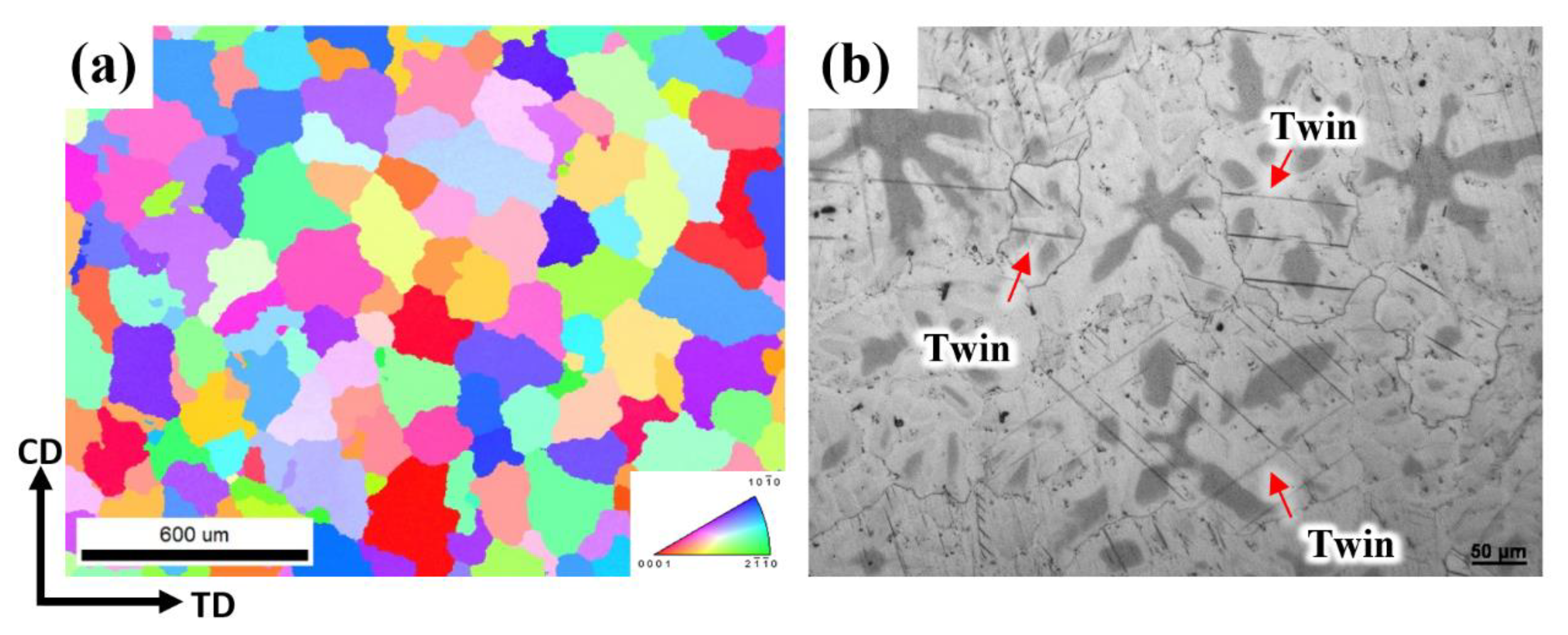
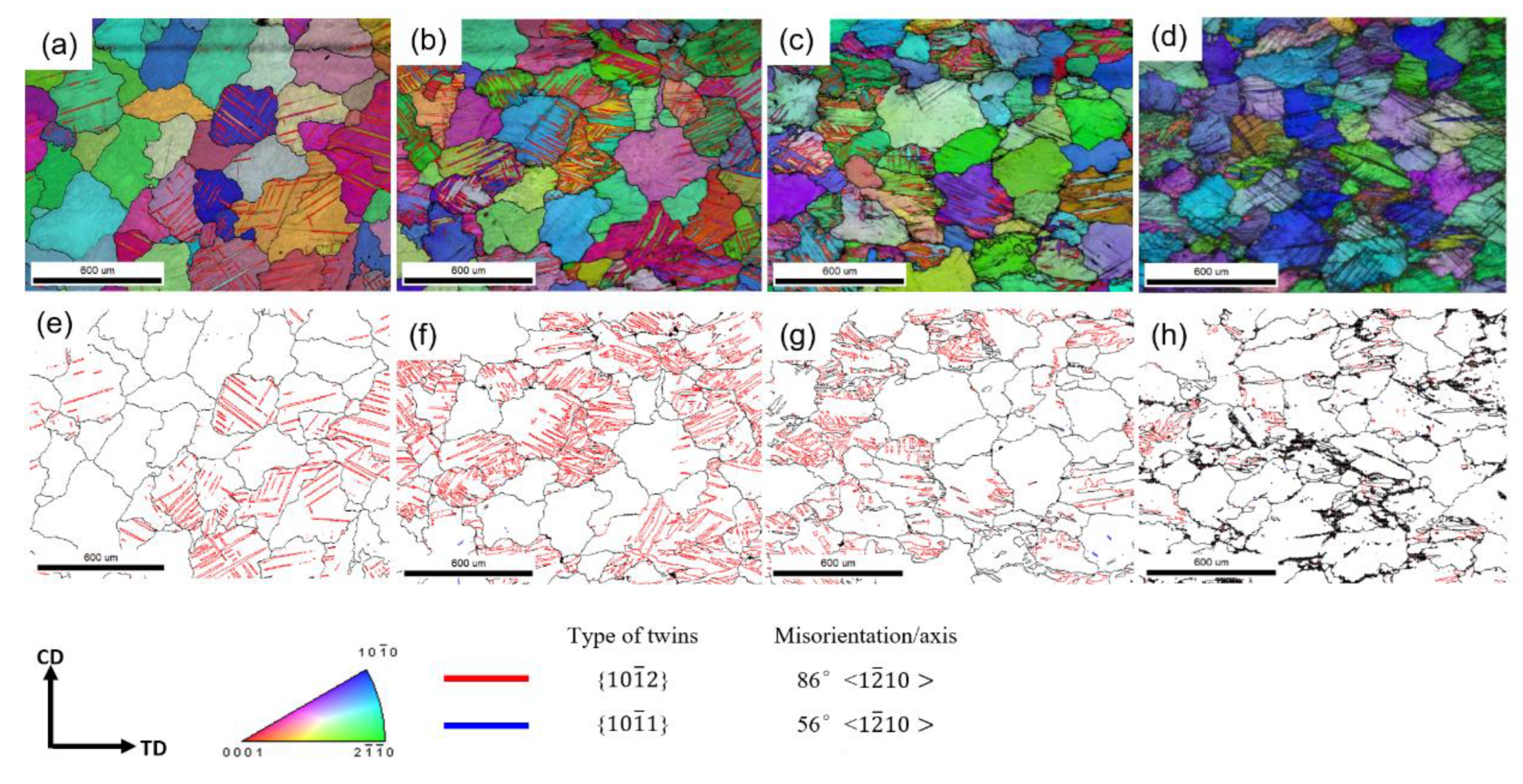

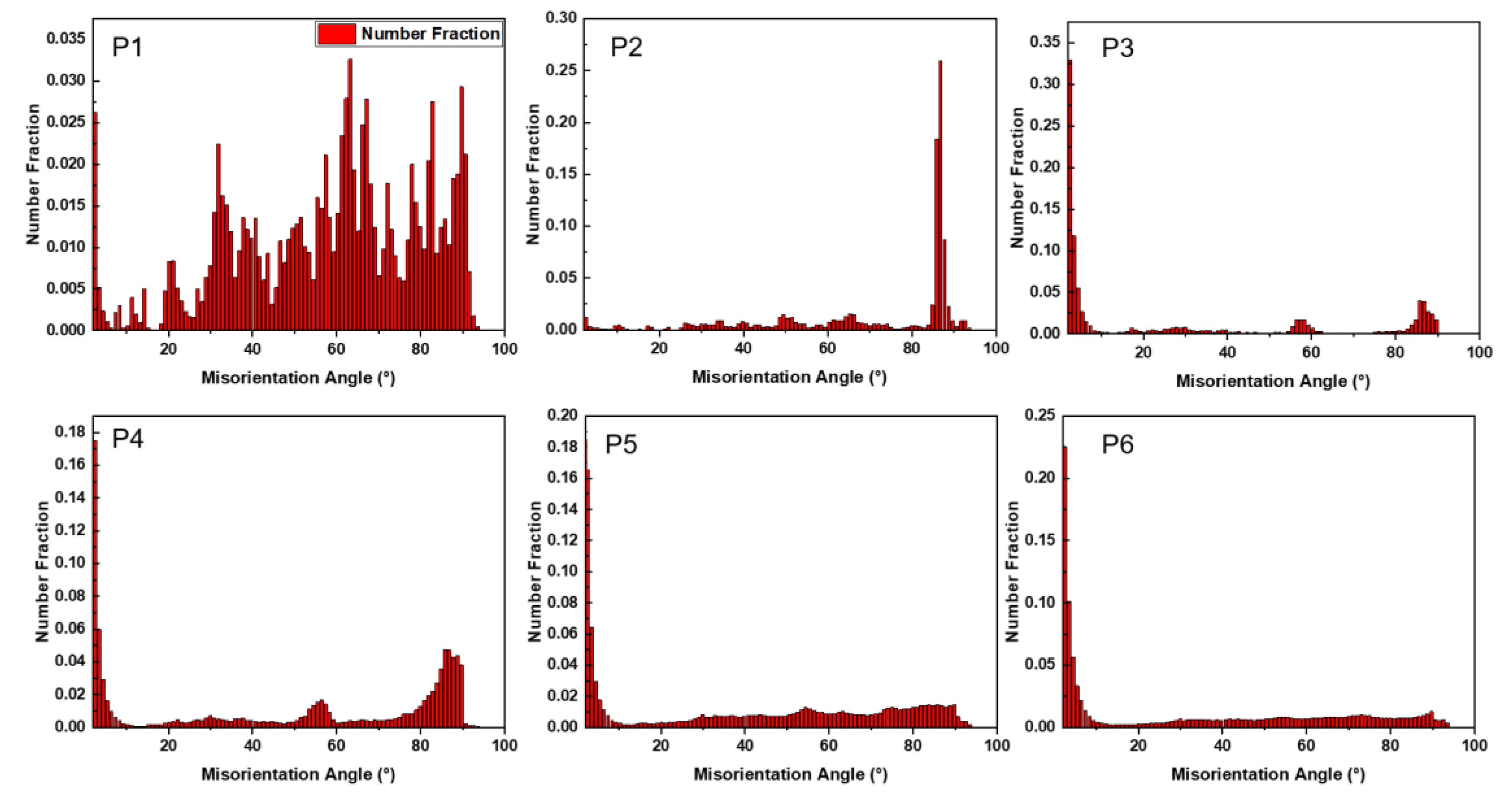
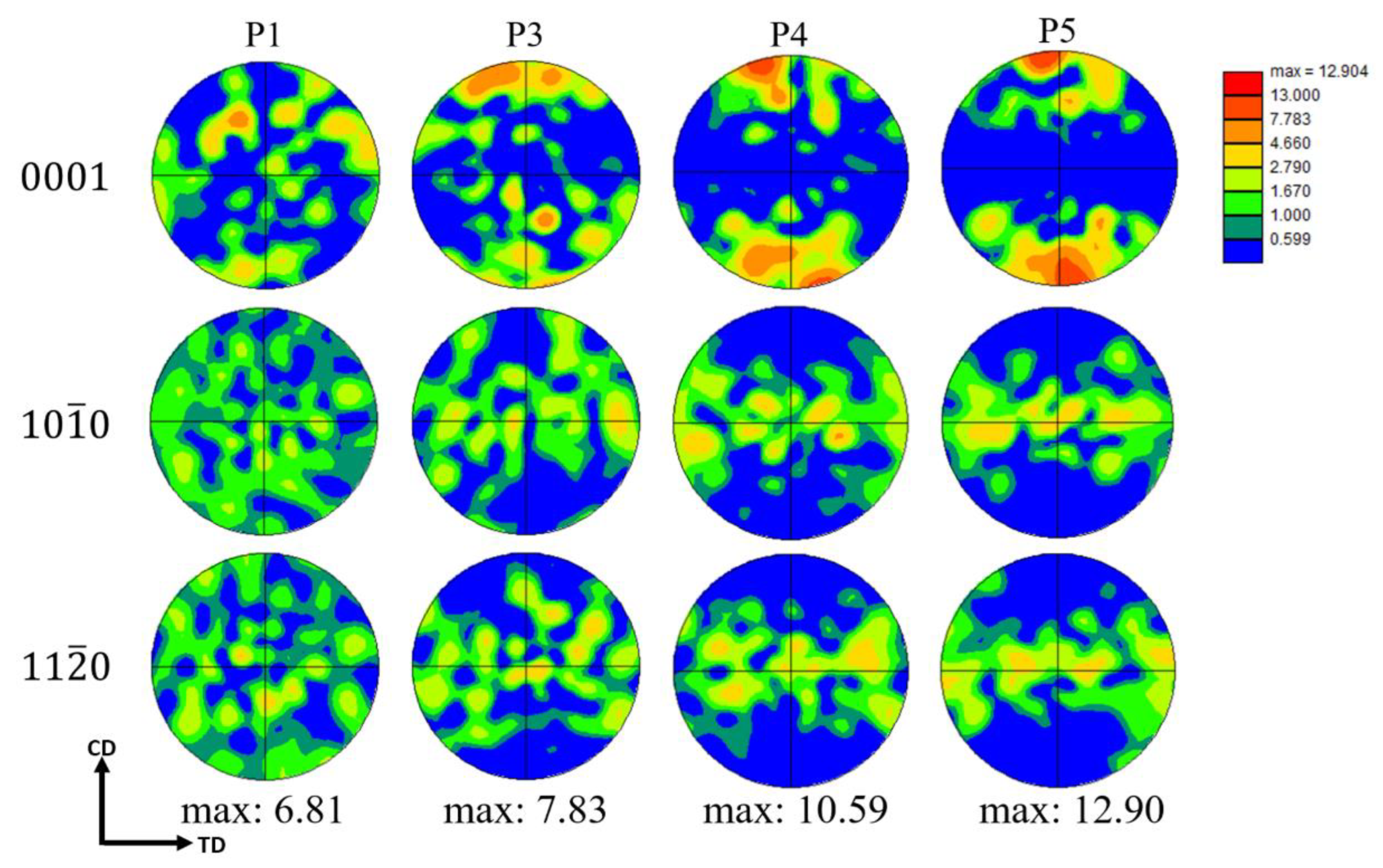




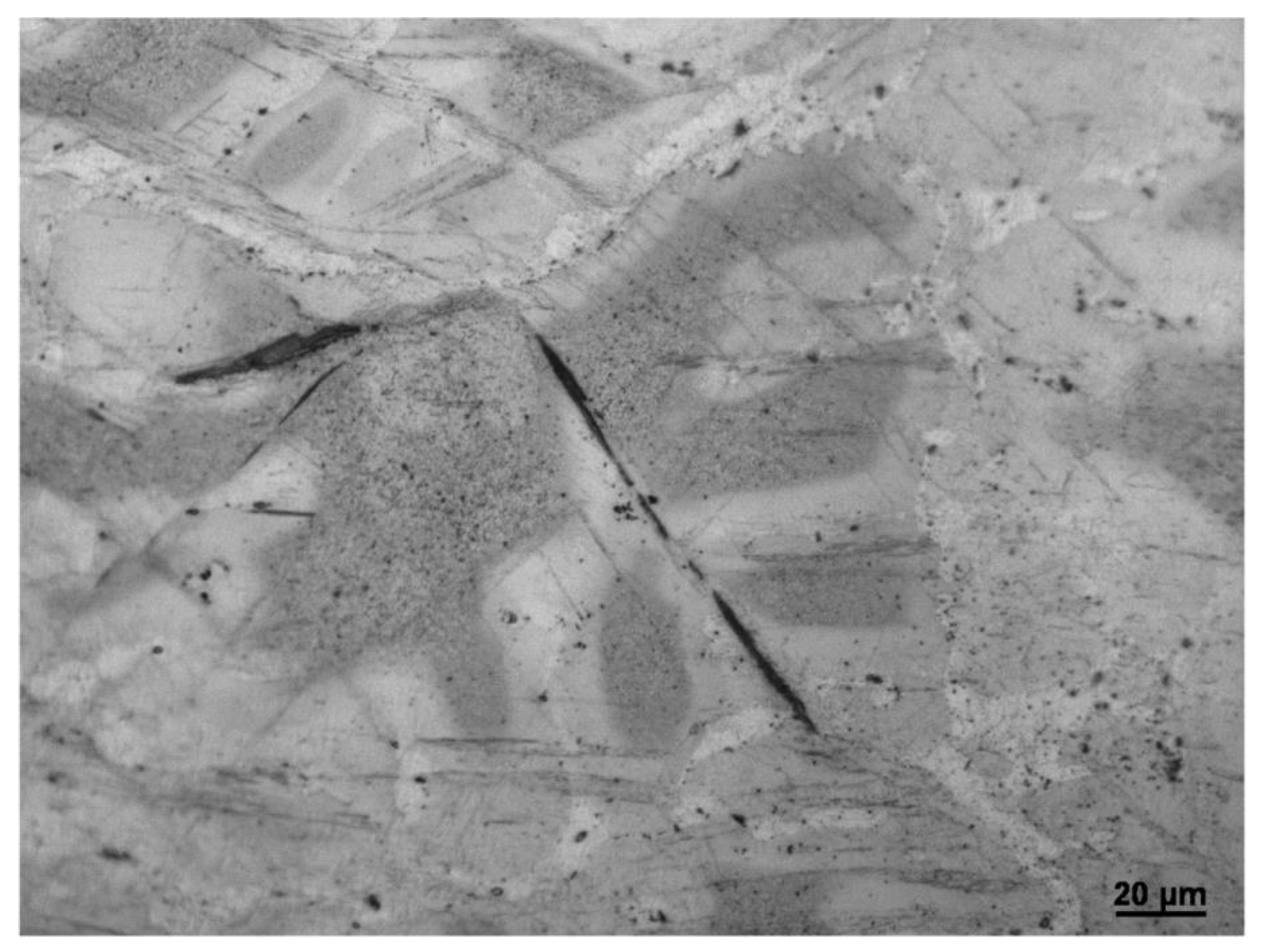
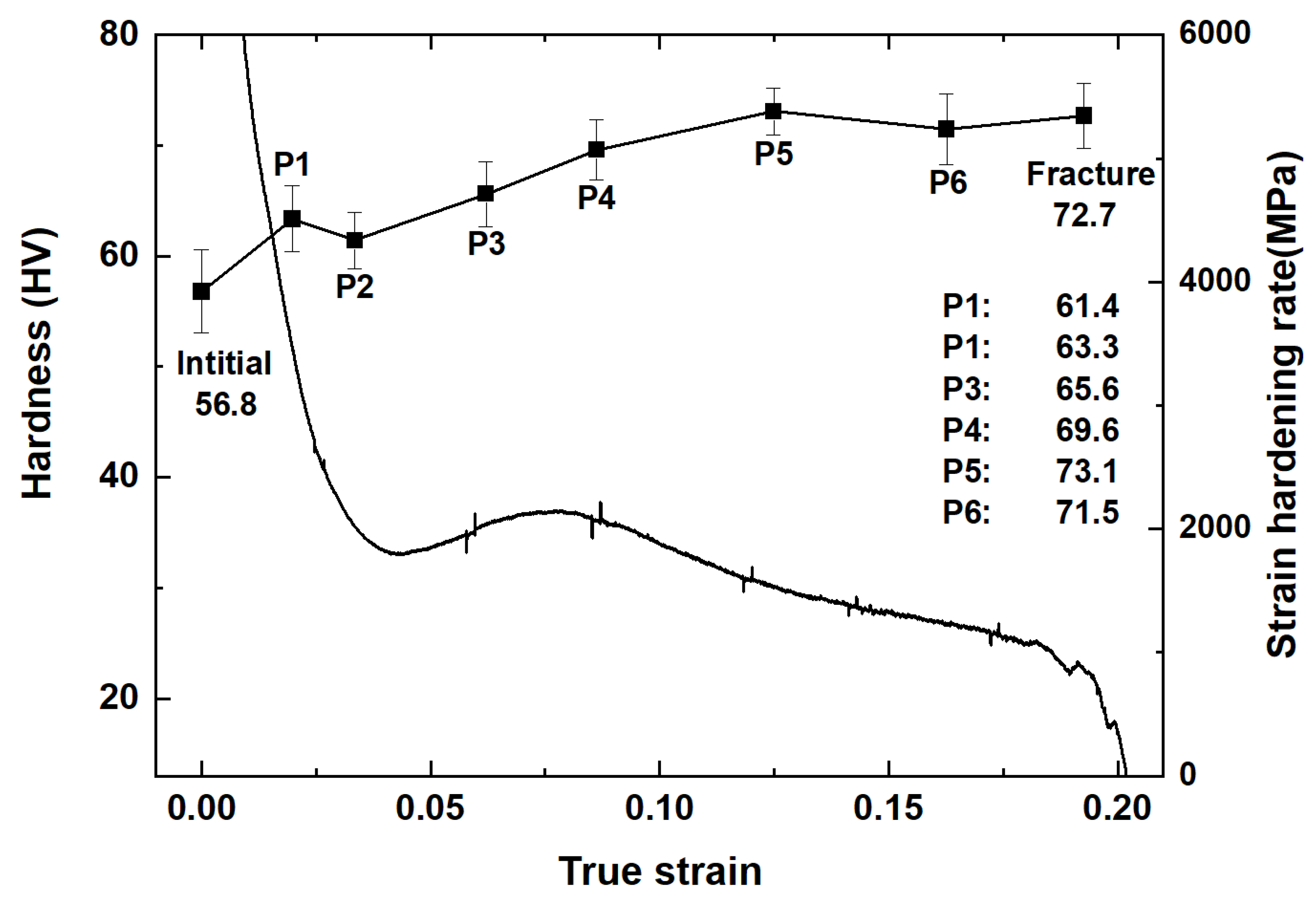
| Mg | Zn | Zr | Y | |
|---|---|---|---|---|
| wt% | Bal. | 5.56 | 0.58 | <0.01 |
| P1 | P2 | P3 | P4 | P5 | P6 | |
|---|---|---|---|---|---|---|
| True Strain | 0.0025 | 0.0275 | 0.055 | 0.091 | 0.136 | 0.187 |
| Engineering Strain | 0.0025 | 0.0279 | 0.057 | 0.094 | 0.146 | 0.206 |
| P1 | P2 | P3 | P4 | P5 | P6 | |
|---|---|---|---|---|---|---|
| LAGBs | 0.053 | 0.032 | 0.569 | 0.308 | 0.332 | 0.479 |
| 86.5° ± 5° | 0.170 | 0.576 | 0.676 | 0.414 | 0.181 | 0.154 |
Disclaimer/Publisher’s Note: The statements, opinions and data contained in all publications are solely those of the individual author(s) and contributor(s) and not of MDPI and/or the editor(s). MDPI and/or the editor(s) disclaim responsibility for any injury to people or property resulting from any ideas, methods, instructions or products referred to in the content. |
© 2023 by the authors. Licensee MDPI, Basel, Switzerland. This article is an open access article distributed under the terms and conditions of the Creative Commons Attribution (CC BY) license (https://creativecommons.org/licenses/by/4.0/).
Share and Cite
Zhang, C.; Wu, D.; He, Y.; Pan, W.; Wang, J.; Han, E. Twinning Behavior, Microstructure Evolution and Mechanical Property of Random-Orientated ZK60 Mg Alloy Compressed at Room Temperature. Materials 2023, 16, 1163. https://doi.org/10.3390/ma16031163
Zhang C, Wu D, He Y, Pan W, Wang J, Han E. Twinning Behavior, Microstructure Evolution and Mechanical Property of Random-Orientated ZK60 Mg Alloy Compressed at Room Temperature. Materials. 2023; 16(3):1163. https://doi.org/10.3390/ma16031163
Chicago/Turabian StyleZhang, Chengyu, Di Wu, Yanda He, Wenyu Pan, Jianqiu Wang, and Enhou Han. 2023. "Twinning Behavior, Microstructure Evolution and Mechanical Property of Random-Orientated ZK60 Mg Alloy Compressed at Room Temperature" Materials 16, no. 3: 1163. https://doi.org/10.3390/ma16031163
APA StyleZhang, C., Wu, D., He, Y., Pan, W., Wang, J., & Han, E. (2023). Twinning Behavior, Microstructure Evolution and Mechanical Property of Random-Orientated ZK60 Mg Alloy Compressed at Room Temperature. Materials, 16(3), 1163. https://doi.org/10.3390/ma16031163





